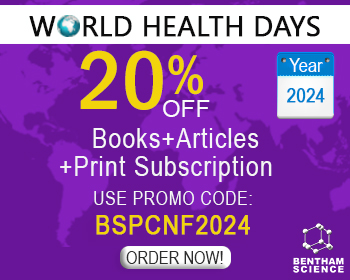Abstract
Botulinum neurotoxins (BoNTs) are the most toxic category A biological warfare agents. There is no therapeutics available for BoNT intoxication yet, necessitating the development of a medical countermeasure against these neurotoxins. The discovery of small molecule-based drugs has revolutionized in the last two decades resulting in the identification of several small molecule inhibitors of BoNTs. However, none progressed to clinical trials. 8-Hydroxyquinolines scaffold-based molecules are important ‘privileged structures’ that can be exploited as inhibitors of a diverse range of targets. In this review, our study of recent reports suggests the development of 8-hydroxyquinoline derived molecules as a potential drug may be on the horizon.
Keywords: Botulinum Neurotoxins (BoNTs), 8-hydroxyquinoline (8-HQ), Small Molecule Inhibitors (SMIs), SNARE proteins, DataWarrior, drug-likeness.
[http://dx.doi.org/10.1001/jama.285.8.1059] [PMID: 11209178]
[http://dx.doi.org/10.3390/bios7030032]
[http://dx.doi.org/10.1152/physrev.2000.80.2.717] [PMID: 10747206]
[http://dx.doi.org/10.1111/j.1348-0421.1995.tb02184.x] [PMID: 7603360]
[http://dx.doi.org/10.1016/S0959-4388(99)80047-6] [PMID: 10395572]
[PMID: 1579114]
[http://dx.doi.org/10.1016/S0968-0004(02)02177-1] [PMID: 12417130]
[http://dx.doi.org/10.1016/S0300-9084(00)00216-9] [PMID: 10865130]
[http://dx.doi.org/10.1038/372415a0] [PMID: 7984234]
[http://dx.doi.org/10.1371/journal.ppat.0030113] [PMID: 17907800]
[http://dx.doi.org/10.1146/annurev.pharmtox.44.101802.121554] [PMID: 14744243]
[http://dx.doi.org/10.1056/NEJMp020071] [PMID: 12167679]
[http://dx.doi.org/10.1136/bmj.320.7228.161] [PMID: 10634738]
[http://dx.doi.org/10.1016/j.coph.2004.12.006] [PMID: 15907915]
[http://dx.doi.org/10.1080/10408410590912952] [PMID: 15839401]
[http://dx.doi.org/10.1016/0002-9343(80)90469-6] [PMID: 7191633]
[http://dx.doi.org/10.1056/NEJMoa051926] [PMID: 16452558]
[http://dx.doi.org/10.1006/scel.1994.1028] [PMID: 7994006]
[http://dx.doi.org/10.1517/17460441.2014.884066]
[http://dx.doi.org/10.1016/j.chembiol.2003.09.002] [PMID: 14522049]
[http://dx.doi.org/10.1016/j.neuint.2012.07.015] [PMID: 22841859]
[PMID: 1653841]
[PMID: 11181932]
[PMID: 6864519]
[PMID: 8169833]
[http://dx.doi.org/10.1016/j.bmc.2009.12.030] [PMID: 20044261]
[http://dx.doi.org/10.1111/cmi.12647] [PMID: 27404998]
[http://dx.doi.org/10.1016/j.bmc.2012.12.001] [PMID: 23340139]
[http://dx.doi.org/10.1080/17460441.2017.1303476] [PMID: 28271909]
[http://dx.doi.org/10.1021/ml300238z] [PMID: 24900641]
[http://dx.doi.org/10.1002/cmdc.201600014] [PMID: 26880501]
[http://dx.doi.org/10.1021/jm101266s] [PMID: 21189019]
[http://dx.doi.org/10.1093/mmy/myx003] [PMID: 28159993]
[http://dx.doi.org/10.1007/s00436-016-5181-4] [PMID: 27365053]
[http://dx.doi.org/10.1021/bi401022b] [PMID: 24325645]
[http://dx.doi.org/10.1021/jm301632e] [PMID: 23445471]
[http://dx.doi.org/10.2174/1568026614666141022095114] [PMID: 25335884]
[http://dx.doi.org/10.2174/1386207043328544] [PMID: 15320713]
[http://dx.doi.org/10.2174/138955707782331722] [PMID: 18045214]
[http://dx.doi.org/10.2174/1386207317666140122101631] [PMID: 24446784]
[http://dx.doi.org/10.1128/AAC.00141-09] [PMID: 19528275]
[http://dx.doi.org/10.1021/acs.jmedchem.6b01393] [PMID: 27966961]
[http://dx.doi.org/10.1016/j.toxicon.2015.02.012] [PMID: 25707753]
[http://dx.doi.org/10.1021/acscombsci.6b00033] [PMID: 27314875]
[http://dx.doi.org/10.1016/j.bmcl.2016.11.019] [PMID: 28043798]
[http://dx.doi.org/10.1021/jm4012164] [PMID: 24387280]
[http://dx.doi.org/10.1016/j.abb.2017.01.006] [PMID: 28137423]
[http://dx.doi.org/10.1016/S0041-0101(96)00215-2] [PMID: 9248007]
[http://dx.doi.org/10.1021/ci800305f] [PMID: 19434825]
[http://dx.doi.org/10.1021/ci500588j] [PMID: 25558886]
[http://dx.doi.org/10.1016/S0169-409X(00)00129-0] [PMID: 11259830]
[http://dx.doi.org/10.1038/srep42717] [PMID: 28256516]



























